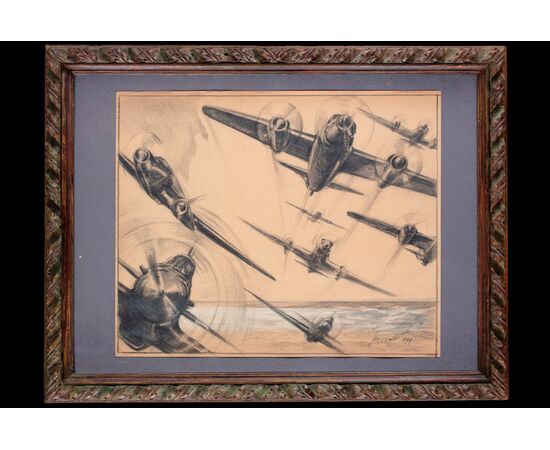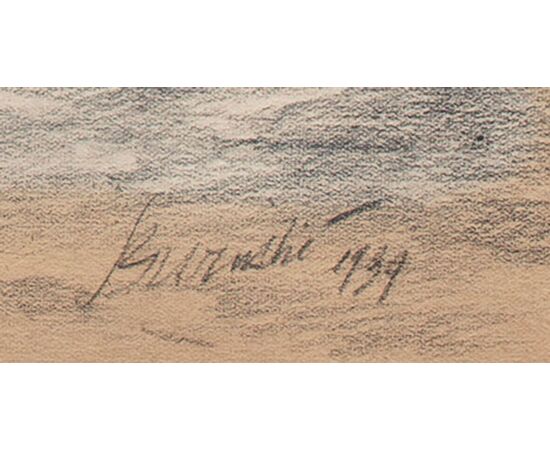Duilio Barnabè (Bologna 1914 - French Alps, Chamonix-Mont-Blanc 1961), Drawing depicting airplanes in flight, 1939
DUILIO BARNABÈ (Bologna 1914 - French Alps, Chamonix-Mont-Blanc 1961), Drawing depicting airplanes in flight, pencil on paper, 28x34 cm, 1939, signed lower right "Barnabè/1939".
The drawing depicts a parade of military airplanes in flight. Although Barnabè did not belong to the Futurist movement, the style of the work is that of Aeropainting, which became very popular between the 1920s and 1930s within the Futurist context. The airplane, a symbol of dynamism with its propellers spinning fast, is the protagonist of this type of work. Barnabè extraordinarily manages to convey the movement of these airplanes, and his stroke is precise and refined.
For this drawing, the artist must have undoubtedly been stimulated by the climate of imminent war, if not already begun, noting the year in which it was made (1939).
BIOGRAPHY
Barnabè was born on October 7, 1914, in Bologna. His training took place at the Academy of Fine Arts in his city, where he followed the teachings of Giorgio Morandi. During his university years, he refined his technical talent and began to develop his personal style. During this period, he also began to sign his works with a pseudonym, "Dubé". After serving in the Italian army in Africa in 1935, he returned to Bologna, where he married the sculptress Angiola Cassanello and resumed his artistic activity.
In 1941, he won the Baruzzi Prize and two years later the Curlandese International Prize.
His style fused tradition and modernity, drawing inspiration from Magical Realism and abstract art, but he was also greatly influenced by other artistic movements of that period such as Surrealism and Cubism, creating a very personal and unique style. His figurative works showed stylized, almost geometric human figures, represented in a simplicity that, however, concealed a formal complexity and a depth of concept that referred to a vision of the world permeated by symbolism and poetry. In addition to figurative works, he also created landscapes and still lifes.
In 1946, he left Bologna and moved to Paris with his wife. Here he was able to come into contact with important artists who pushed him towards experimenting with new forms of expression. His style evolved, and the way of delineating forms became even simpler.
Some of the exhibitions that can be remembered in these years are at the Kunsthalle Bern in Switzerland in 1947 and at the Rome Quadrennial and the Venice Biennale the following year.
The 1950s mark the most fruitful period for the artist: his works were exhibited in various European and American galleries, gaining appreciation for his unique and expressive style. Notable are the solo exhibition he held in 1952 at the Venice Biennale and the work he did for the church of San Nicolao della Flue in Lugano three years later, for which he received a gold medal from the government.
During this period, Barnabè's work reached its highest level of abstraction: he reduced figures and still lifes to geometric symbols. At the end of the 1950s, however, his fidelity to realism led him to experiment with adding more descriptive details to his paintings, but he was not satisfied with the result. This artistic problem, along with the crisis caused by the loss of religious faith, left him mentally and physically drained.
On October 7, 1960, he attempted suicide by driving his car off a mountain road in the French Alps, near the Swiss border. Exactly one year later, he returned to the same spot at the same time and threw himself off the same road, killing himself.




